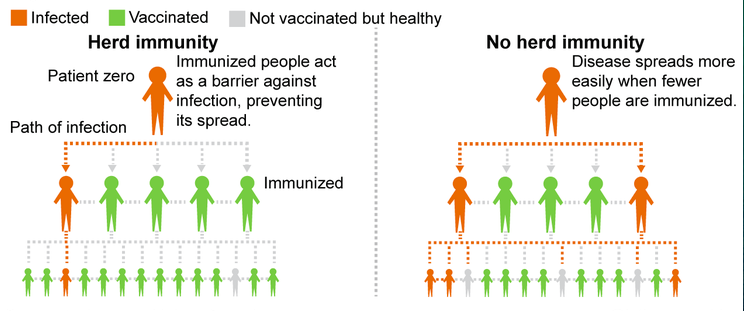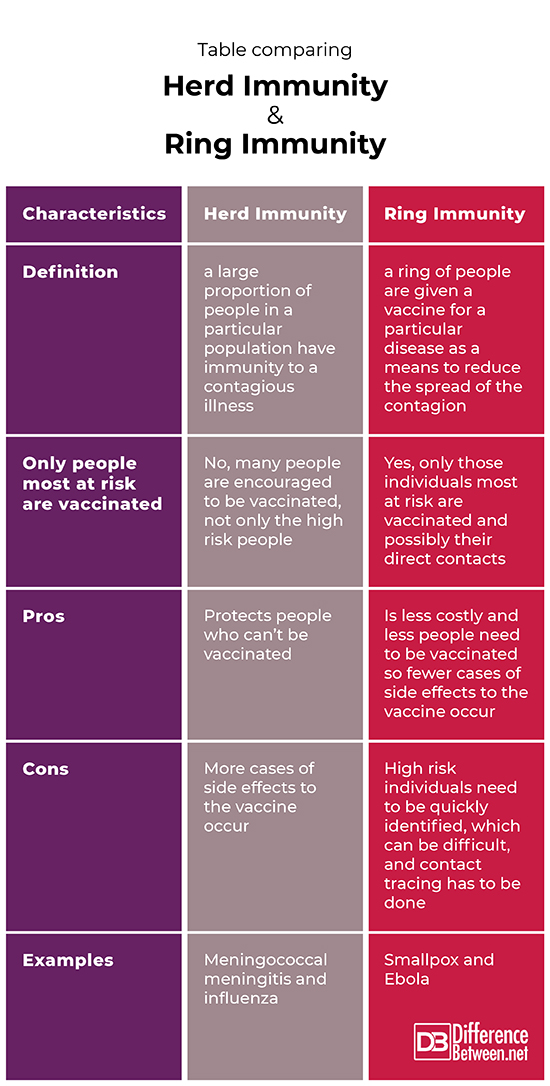Difference Between Herd Immunity and Ring Immunity
Herd immunity is when a fairly large percent or proportion of a population acquires immunity. Ring immunity is when only a ring of people are vaccinated against a disease.

What is Herd immunity?
Definition:
Herd immunity is when a large proportion of people in a population have immunity to a particular illness; this can be because of prior illness or, more often, it is used to describe what happens due to a vaccination strategy. Immunity in general means the body’s immune system is protecting an individual from disease.
Examples:
Meningococcal vaccination has proven very effective in reducing illness in the population; each year the influenza vaccine also provides herd immunity for populations where several people are vaccinated. The idea of herd immunity to control COVID-19 is a contentious issue that has been discussed, with some believing it is possible to achieve herd immunity without a vaccine, while others in the scientific community maintain that a vaccine is needed.
Advantages:
A major benefit with herd immunity in the case of vaccination is that it acts to protect anybody who may not be able to get a vaccine due to, for instance, allergies to vaccine ingredients. The more people who are immune due to vaccination or exposure, the lower the probability of other individuals becoming infected by a contagious disease.
Disadvantages:
It requires many individuals to either get sick or willingly get vaccinated. Some people may refuse vaccination, and if enough people refuse to be vaccinated then herd immunity may not take place. For very contagious illnesses such as measles more than 90 percent of the population has to be vaccinated for herd immunity to be effective. Herd immunity is not to be confused with natural biological immunity and unvaccinated people who gain indirect benefits may still become ill at a later stage. There are also more cases of adverse events and reactions to the vaccine because more people are vaccinated.

What is Ring immunity?
Definition:
Ring immunity is when a ring of people are given a vaccine for a particular disease as a means to reduce the spread of the contagion through the population; the idea is to only administer the vaccine to people who are most likely to be infected with the disease. Ring immunity can be confused with herd immunity but it is only particular individuals who are vaccinated.
Examples:
Ring vaccination was used to control smallpox; groups of people in hot spots of infection were given the smallpox vaccine, and eventually smallpox in nature was eradicated. This same strategy was used in 2018 in an attempt to control an Ebola outbreak in Africa.
Advantages:
Ring vaccination means that less of the vaccine needs to be made available and less people need to be vaccinated. It also means that there is a reduced chance of adverse side effects from the vaccine since fewer individuals are vaccinated.
Disadvantages:
One weakness of ring vaccination is that health officials have to be quick to find which individuals are at highest risk of the disease, and vaccination needs to be rapidly implemented. Contact tracing is crucial with ring vaccination programs to establish who may already be infected with the pathogen and who they may have infected.
Difference between Herd immunity and Ring immunity?
Definition
Herd immunity describes the situation when several people in a population have immunity to a contagious illness. Ring immunity is when a small number of people who are most at risk of an illness are vaccinated.
Only people most at risk are vaccinated
In the case of herd immunity, most of the population is vaccinated. In the case of ring immunity, only the individuals at highest risk of infection in the population are vaccinated.
Pros
The benefit of herd immunity is that it functions to protect those people who cannot be vaccinated for whatever reason. The benefit of ring immunity is that less of the vaccine is needed and thus there are fewer cases of adverse side effects.
Cons
Since most of the population is vaccinated to achieve herd immunity, there are many more chances of adverse reactions to the vaccine. In ring immunity, very quick identification of high risk people has to be done and contact tracing is important; this all adds difficulty to the process.
Examples
Examples where vaccination for herd immunity was done were for meningococcal meningitis and influenza. Examples where vaccination for ring immunity was done include Ebola and smallpox.
Table comparing Herd immunity and Ring immunity

Summary of Herd immunity Vs. Ring immunity
- Herd immunity and ring immunity both involve vaccination strategies to help stop the rapid spread of an infection through a population.
- Herd immunity relies on enough people being immune to an infection that people who can’t be vaccinated are protected.
- Ring immunity is vaccination that targets specific individuals in a population.
- Ring and herd immunity both have advantages and disadvantages when dealing with a contagious disease.
- Difference Between Rumination and Regurgitation - June 13, 2024
- Difference Between Pyelectasis and Hydronephrosis - June 4, 2024
- Difference Between Cellulitis and Erysipelas - June 1, 2024
Search DifferenceBetween.net :
Leave a Response
References :
[0]Fine, Paul, Ken Eames, and David L. Heymann. "“Herd immunity”: a rough guide." Clinical infectious diseases 52.7 (2011): 911-916.
[1]Kretzschmar, Mirjam, et al. "Ring vaccination and smallpox control." Emerging infectious diseases 10.5 (2004): 832.
[2]Rashid, Harunor, Gulam Khandaker, and Robert Booy. "Vaccination and herd immunity: what more do we know? " Current opinion in infectious diseases 25.3 (2012): 243-249.
[3]Image credit: https://commons.wikimedia.org/wiki/File:Herd_Immunity_vs_Without_Herd_Immunity_.png
[4]Image credit: https://commons.wikimedia.org/wiki/File:Herd_immunity.svg
